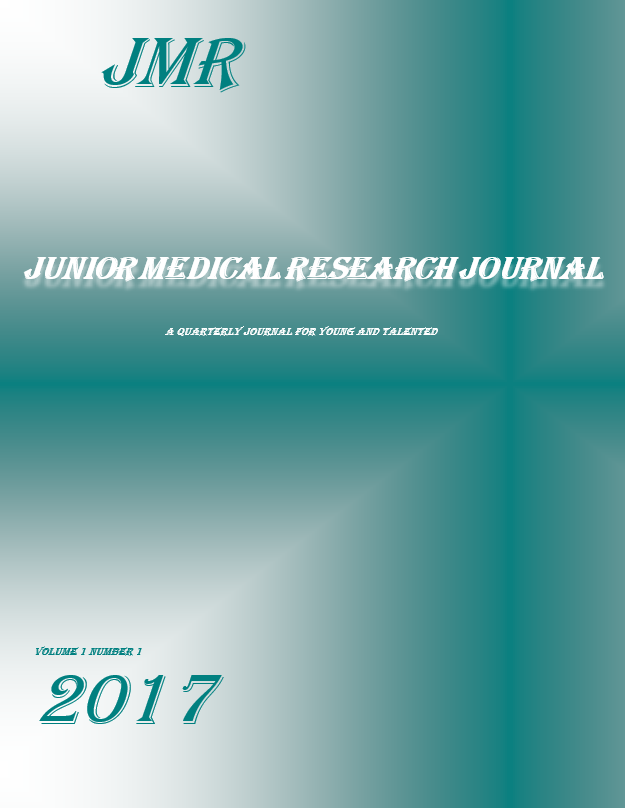
Junior medical research (JMR) is a peer review open access online journal. JMR quarterly publishes theoretical, empirical and experimental papers that contribute significantly to all disciplines of medical research. The journal aims to promote the skills of junior researchers and medical students in the scientific writing and publishing exercise.
Authors submission guidelines are summarized from the Uniform Requirements for Manuscripts Submitted to Biomedical Journals : www.icmje.org
Terms and policies of submission
Submission is on the understanding that the article has not been previously published in any other form and is not under consideration for publication in another journal. Exceptions can be made after the approval of the editorial board and after required disclosure for lectures and academic thesis.
It is important to agree upon standards of ethical behavior and the policies of submission to biomedical journal. Ethics topics to consider when submitting:
- Authorship of the paper: Authorship should be limited to those who have made a significant contribution. Except permission; the author’s list cannot contain more than four. To highlight vision and mission of this journal it is recommended that three of the participating authors are residents, junior researchers or medical students.
- Originality and plagiarism: The authors should ensure that they have written entirely original work, and if the authors have used the work and/or words of others, that this has been appropriately cited and quoted.
- Reporting standards: Authors of reports of original research should present an objective and significant discussion of the published work.
- Conflicts of interest: All submissions must include disclosure of all potential conflicts of interest.
- Data access: Authors may be asked to provide the raw data in connection with a paper for editorial review.
- Acknowledgement of sources: need to be proper.
- Fundamental errors in published works: error or inaccuracy in the published work is the author’s responsibility. Authors have to promptly notify the journal editor.
- Hazards and human or animal subjects: Statements of compliance are required if the work involves chemicals, procedures or equipment that have any unusual hazards inherent in their use, or if it involves the use of animal or human subjects.
- Use of patient images: Studies on patients or volunteers require ethics committee approval and informed consent, which should be documented in the paper.
- Peer Review policies: All manuscripts are subject to double-blind system for peer-review; the reviewer(s) identities remain anonymous to authors. The paper will be peer-reviewed by three experts; one is an editorial board member and the other two are external reviewers. The review process may take 20 days. Decisions will be made as fast as possible, and reviewer(s) comments sent to the author immediately.
Submission of manuscripts
Manuscript should be submitted online via http://jmedicalresearch.com. Upon receipt of manuscript submission, an e-mail of confirmation is sent to the corresponding author within 1-2 working days. In absence of a confirmation email, you are advised to contact the authors assistant via: authorassist@jmedicalresearch.com. The aim of the journal support committee is to provide help in the manuscript editing and a first local review and can unofficially advise some modifications. This committee can be contacted early from the first step of the manuscript elaboration. The editorial board coordinator will invite one member of this committee upon request from the authors: coordinator@jmedicalresearch.com
Before the submission ensure that:
- One author has been designated as the corresponding author and full contact details are provided.
- All necessary files have been uploaded: Manuscript: Include keywords • All figures (include relevant captions) • All tables (including titles, description, footnotes) • Ensure all figure and table citations in the text match the files provided
- Manuscript has been ‘spell checked’ and ‘grammar checked’ All references mentioned in the Reference List are cited in the text, and vice versa • Permission has been obtained for use of copyrighted material from other sources • A competing interests statement is provided • Journal policies detailed in this guide have been reviewed
Organization of manuscripts
All submissions should contain a cover letter. This letter includes:
- The full name of the author(s).
- The department(s) institution(s) in which the work was done including full contact address telephone/fax numbers of the corresponding authors.
- Brief presentation of the work submitted
4.The author should certify the originality of the work and declare competing interest if any.
The cover letter It should be mailed message sent to the Editor-in-chief along with the article: editor@jmedicalresearch.com
Types of Articles:
- Original Research Articles:
It should describe new and carefully analyzed and confirmed findings. The article include in the main paper an abstract of 300 words maximum ; a set of key words followed by introduction, material and methods, results, discussion, acknowledgment and references. The length of the manuscript should not exceed 6000 words with 40 references unless exception approved by the editor in chief.
- Reviews:
A review article typically presents a summary and critical evaluation of information that has already been published, and considers the progress of current research toward clarifying a stated problem or topic. Reviews should be concise with maximum of 12000 words and 60 references. We encourage the submission of systematic reviews.
- Clinical Opinion:
It is short article (less than 300 words) that comprise compelling well argued comment. This article section can be suitable for inspiring reflections on any aspect of the author’s clinical practice or teaching experience ; an unusual presentation that modified the standard management or a clinical critical review about one of the published articles. For this kind of submission ; written patient consent ; competing interest statement ; and a short biography of the authors are mandatory. References should be included as hyperlinks.
- Case Reports:
A medical Case Report should be original and provide adequate detail of a single patient case. It does not need to describe an especially unusual case as there is benefit from collecting details of many standard cases. Medical student are encouraged to submi in this section their clinical experience in the training centers after consent of the patient and approval from the training coordinator. Article can be published after short peer review process granted by the support committee.
- Correspondence:
Correspondence articles are short, peer reviewed comments directly relating to one or more articles published in JMR or other journals. Correspondence articles must provide scholarly discussion, supported by evidence from the published literature
- Commented video :
This section can include video of surgical procedures ; elementary teaching videos ; or short speech. The video duration cannot exceed 6 minutes ; supported format are jpeg and jpg. For surgical procedure ; the submitted materiel should include a cover letter and a short case presentation of 200 words maximum.
- Lectures Communication :
These should present a concise innovative study. This section is suitable for preliminary research finding presented in a national or international meetings or conferences. The material submitted should include a cover letter ; competing interest statement and a powerpoint document describing the study of maximum 25 slides.
- Doctoral thesis :
This section aims to increase the visibility of undergraduates doctors and medical residents work experience during the elaboration of their doctoral thesis. The thesis will be fully published after the corresponding university acceptance. Only two authors can be cited : the candidate and the supervisor. The editor in chief will allow upon request the submission of original articles on the same subject to other journals.
For all submissions if applicable :
The manuscript must be typed double-spaced (Tahoma 12) and all pages numbered starting from the title page. The Title should be a brief phrase describing the contents of the paper. The Title Page should include the authors’ full names and affiliations, the name of the corresponding author along with phone, fax and E-mail information. An asterisk (*) must be placed after the corresponding authors name as superscript whose email, fax, telephone number can be given at the bottom left corner of the title. Corresponding author has the responsibility to ensure that all co-authors are aware and approve the contents of the submitted manuscript.
The abstract should contain the objective, description of study material and methods ; result and conclusion. Authors may list a maximum of six keywords for subject classification.
Abbreviations are to be used sparingly and given at first mention of word. Each abbreviation should be spelled out and introduced in parentheses the first time it is used in the text. Only recommended SI units should be used.
The Introduction should provide a clear statement of the subject, the relevant literature findings, and the proposed approach. Materials and Methods should be sufficiently detailed. Sources of materials used must be given and statistical method must be specified. The Results must be clearly and concisely illustrated with appropriate material tables and/or figures. The Discussion should interpret the findings in view of the results obtained. Appropriate confrontation with the literature findings increase the scientific discussion value.
Acknowledgments should be included at the end of the of the paper before references.
Tables are numbered consecutively in Arabic numerals and supplied with a heading and a legend. Each table should include a title and be comprehensible without reference to the text. Tables adapted or reproduced from another source must acknowledge that source in footnote.
Figure legends should be typed in numerical order. Graphics should be prepared in high resolution GIF, TIFF, JPEG or PowerPoint before pasting in the Microsoft Word manuscript file. Use Arabic numerals to designate figures and upper case letters for their parts (Figure 1). Begin each legend with a title and include sufficient description so that the figure is understandable. Information given in legends should not be repeated in the text.
Tables and Figures should be presented at the end of the paper.
References : Authors are fully responsible for the accuracy of the references. All references should be cited within the text; otherwise, these references will be removed. References should be arranged and sorted chronologically as they appear in the text. Journal names are abbreviated according to the ISSN List of Title Word Abbreviations. Only updated Vancouver referencing style will be accepted.
Copyright: Submission of a manuscript implies: that the work described has not been published before that it is not under consideration for publication in another journal; Open Access authors retain the copyrights of their papers, and all open access articles are distributed under the terms of the Creative Commons Attribution license, which permits unrestricted use, distribution and reproduction.




